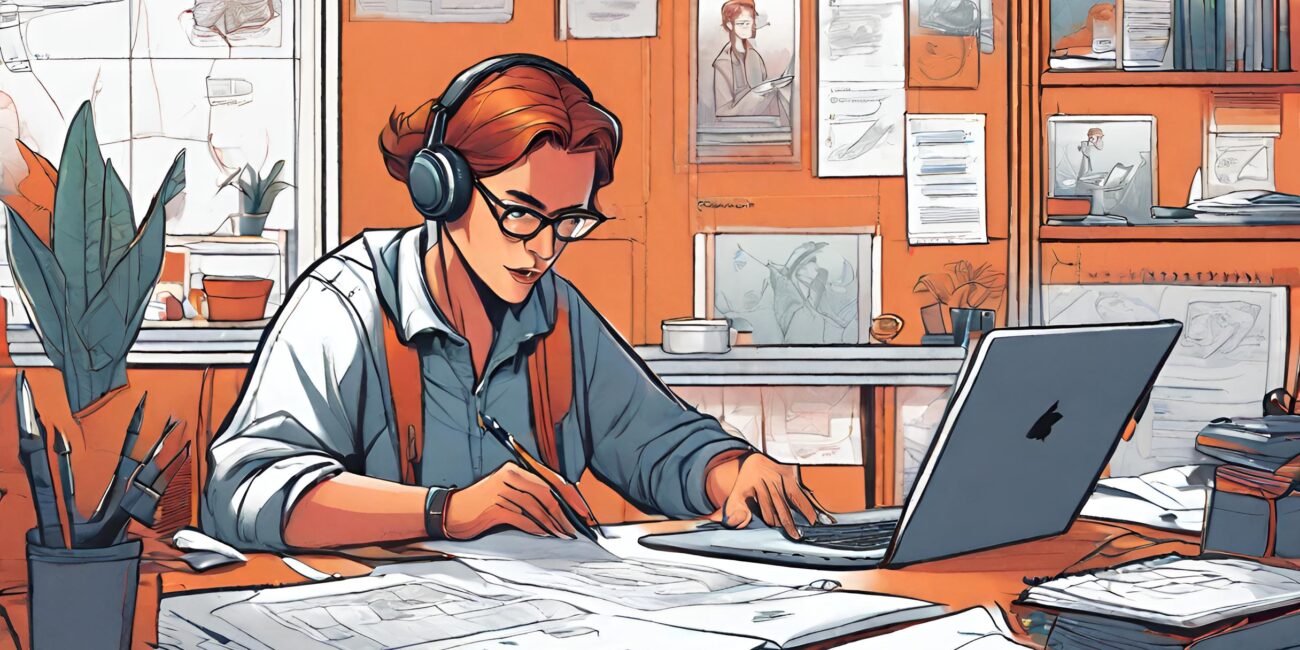What is Academic Editing: A Guide for Academic Writers and Editors

Academic editing is the process of reviewing and improving scholarly writing to ensure it meets the expected quality, style, and formatting standards. It encompasses everything from proofreading for grammar and spelling errors to providing substantive feedback on the structure, flow, and presentation of arguments within a paper.
For academic writers, investing in academic editing services can contribute to getting published or rejected, passing or failing a course, or completing a degree programme. Professional editors are invaluable in refining academic work and highlighting ways for improvement that writers may overlook, especially given their closeness to the material.
This comprehensive guide explores the scope, services, and specifics of academic editing for different document types. Whether you’re a student looking for editing help, an academic seeking to polish a journal article, or a writer wanting to learn more about this field, we hope you find some valuable insights here.
Get Your Academic Editing Checklist
The easy way to ensure you don't miss a thing in an academic text
Table of Contents
Key Elements of Academic Editing
The type of document will determine which academic editing elements the editor applies, but these are some core areas they focus on:
- Structure and organisation: Editors evaluate and advise on overall paper structure, paragraph flow, transitions, and logical presentation of ideas.
- Clarity and coherence: Unclear writing can undermine the quality of academic work. Editors pinpoint fuzzy passages and suggest improvements for clarity.
- Grammar and syntax: Editing catches grammar errors and enhances academic style through sentence variety, precision, and readability.
- Citation and referencing: Editors check for proper citations and a consistent referencing style to avoid plagiarism concerns.
- Plagiarism checking: Editors screen documents for passages copied from other sources and help integrate citations appropriately.
Top tip: As an editor, you’re not supposed to write the academic text for your client. You should only improve the material you have to work with, whether that’s fixing grammatical errors or advising on sections needing a rewrite.
The Scope of Academic Editing

Academic editors work on a wide variety of scholarly documents across disciplines. Major types include dissertations, theses, essays, and journal articles. We’ve broken down each of these:
Dissertations
Dissertations are lengthy, original research documents graduate students write to complete their degree programmes. This means that dissertation editing requires specialised expertise to help the student polish this document to the high scholarly quality expected for a PhD.
Make no mistake, it’s a big job. Dissertations can range from 80,000 to 120,000 words but some are 150,000+. While each dissertation comes with its own challenges, typical writing hurdles include effectively synthesising research, sustaining a central thesis across lengthy chapters, incorporating committee feedback, meeting academic writing standards, and proper citation formatting.
That’s why dissertation editors are core to appraising argument quality, checking for gaps in logic, assessing flow, and highlighting wordiness. Plus, they ensure dissertation formatting, structure, front matter, in-text citations, and references align with university requirements.
Top tip: To make the most of dissertation editing, students should choose editors with dissertation experience—bonus points if the editor is a subject expert too.
Theses
Theses require students to demonstrate mastery of a subject by presenting an evidence-based academic argument at an honours or masters level. This means that conciseness, coherence, adequate literature review, proper sourcing, citation accuracy, logical flow, and grammar can all pose challenges when writing a thesis.
The role of academic editors here is to strengthen academic analysis, refine presentation, assess logic flow, improve readability, check citations, and ensure formatting consistency. This goes hand-in-hand with carefully checking departmental thesis guidelines related to structure, length, formatting, front matter, and references.
Essays
From short class assignments to application letters, essays are a key component of academic writing. Issues like weak topic sentences, unsupported claims, unclear transitions, redundancy, poor phrasing, and citation errors can undermine essay quality.
In this case, editors provide an expert critique to help students craft persuasive arguments, improve presentation, enhance clarity, and remedy writing issues.
Our earlier editing tip about not writing the academic text for your client? That’s especially relevant here. Because essays are shorter compared to dissertations and theses, some students may have the incorrect view that editors will write sections (or all) of the essay for them. Again, the editor’s role is not to write, but to enhance.
Top tip: For the best editing feedback, students should clearly explain assignment parameters to the editor, allow time for revisions, and have an open mind about suggestions.
Peer-Reviewed Journal Articles
Peer-reviewed journal articles report original research findings and undergo rigorous critique before journal publication. Apart from satisfying peer reviewer expectations, the academic must also demonstrate novel findings, back claims with evidence, effectively integrate citations, and meet rigid length and formatting guidelines.
While writing journal articles seems less glamorous than edited collections or monographs, it’s an effective way for academics to share original research with other scholars and enhance their professional status.
So, because peer-reviewed journal articles are more concentrated, they require meticulous editing. Academic editors evaluate argument quality, assess flow, improve readability, check citation integration, advise on journal guidelines, and prepare articles for peer scrutiny.
Copy Editing in Academic Writing
In many cases, an editor may be roped in to look after the language only. Other “big picture” elements or editing types have been or will be addressed by someone else.
Copy editing focuses on line-by-line grammar, spelling, punctuation, phrasing, and readability improvements. For example, passive voice, misspelt words and typos, punctuation problems, awkward phrasing, and repetitive wording.
Top tip: Keep a style sheet handy while you edit. This documents all your style choices like specific spellings (US vs UK, one word, two words, hyphenated), abbreviations and acronyms, capitalisations, how you implement numbering and superscripts, and more. This makes checking what you’ve implemented much easier than paging back and forth through the manuscript.
Reference Formatting and Citation Styles

Properly formatting citations and references is a vital part of academic editing services—to the point where many editors charge separately for it. It’s that much work.
Overview of Major Citation Styles
The main citation styles used in academic writing are:
- APA (American Psychological Association): Focuses on clarity and comprehensiveness and is typically used in social sciences, education, psychology, and some business areas.
- MLA (Modern Language Association): Typically appears in humanities, languages, and literature because it emphasises source information (author, title, publisher, year).
- Chicago: A flexible referencing style that adapts to different disciplines like humanities, history, arts, and some areas of business.
- Harvard: Widely used in the UK and other parts of the world, Harvard typically appears in humanities, social sciences, law, and some business areas.
Each citation style has different formats and rules for aspects like book vs journal citations, punctuation use, capitalisation, author names, and ordering of elements. Keeping these styles separate can prove challenging, making an editor’s trained eye essential.
How Editors Ensure Proper Reference Formatting
Properly formatted in-text citations and references are crucial for giving credit to source material and avoiding plagiarism allegations. To help writers achieve this, academic editors check for citation consistency and accuracy in the text itself, the reference page or bibliography, footnotes, and endnotes.
This means ensuring references have all the necessary elements and adhere to the designated style guide. For example, the bibliography needs to be in alphabetical order. Or if in-text references are (Smith 2024:1), no comma after the surname and no space after the colon, then all of the in-text references need to look this way.
Top tip: If the citation style requires you to include DOIs (Digital Object Identifiers), don’t search for them manually. Copy and paste your entire bibliography into Simple Text Query from Crossref to bulk check.
Plagiarism Checking in Academic Editing
Plagiarism involves presenting others’ words or ideas as your own without proper attribution through quoting, paraphrasing, and citing sources. This is considered unethical and often illegal, leading to consequences like disciplinary action, reputational damage, unemployment, and legal action.
Editors look for missing, improper, or inconsistent citations that could constitute plagiarism. They ensure writers properly integrate sources and provide guidance on properly paraphrasing, summarising, and quoting source material.
Tools for Plagiarism Checking
Editors utilise plagiarism-detection software and comparative text analysis to identify passages copied from other works without citations. There are many free and paid tools available.
Free tools
- Grammarly: While primarily a grammar checker, Grammarly also offers basic plagiarism checking against billions of web pages and its own database. It’s a good option for catching accidental plagiarism or paraphrasing issues.
- DupliChecker: This free tool allows you to check up to 1,000 words at a time and highlights potential plagiarism sources. However, it doesn’t provide detailed reports or comparisons.
Paid tools
- Turnitin: Widely used in academic institutions, Turnitin offers comprehensive plagiarism checking against a massive database of scholarly sources and student papers, giving you detailed reports and originality scores. It can be expensive for individual users, but most students and academics should have access via their institution.
- Unicheck: This user-friendly software checks for plagiarism against sources like web pages, academic databases, and your own file archives. It offers different pricing plans depending on your needs.
- Quetext: Popular for its ease of use and affordability, Quetext provides plagiarism checking with colour-coded highlights and detailed reports. You can choose between various subscription plans and pay-per-use options.
- ProWritingAid: This grammar and style checker also includes plagiarism checking against online sources and internal databases. It’s a good option for editors and writers who want a multi-functional tool.
Finding the Right Academic Editor

Selecting the right editor for your project requires an informed evaluation based on a few key factors:
What Qualities Should an Academic Editor Have?
Experience editing similar document types:
- Specialised expertise in your field
- Demonstrated commitment to quality
- Transparency about services
- Training from respected institutions
- Glowing client testimonials
Online Academic Editing Tools
There are several online tools that can assist editors and writers at almost every stage of their academic work: analysing readability, checking plagiarism, providing writing feedback, and helping with citations.
Some of our favourite tools include:
- Grammar and style issues: Grammarly, Hemingway Editor, ProWritingAid, and Scribbr
- Formatting references: Citationsy and Scribbr
Pros and Cons of Online Editing Tools
Online academic editing tools are great for quick, automated feedback and catching surface-level errors. Anyone in the industry can sympathise with missing mistakes because you’ve been staring at the screen for too long.
However, these tools can’t give you nuanced individual feedback and often miss context-specific issues. So, by simply accepting any online tools’ feedback, you risk introducing new errors and losing your unique writer voice. That’s why a human editor’s touch is still vital.
Top tip: Combine feedback from online tools and editors. Use online tools for an initial check but subsequently partner with an editor for expert, personalised feedback to get the best of both.
The Future of Academic Editing: Let’s Chat About AI

The rise of Artificial Intelligence (AI) has sparked heated debates about its potential impact on academic writing and editing. As we’ve discussed, using online editing tools is beneficial, especially when it comes to streamlining workflows and picking up mechanical language tasks. However, most of the academic AI conversation is about ethics.
Every language practitioner has been keeping tabs on the news and knows about at least one story where a student submitted an AI-generated assignment or an academic tried to pass off an AI-written journal article as their own.
This is a problem, not just because these people are being plainly dishonest, but because they’re going against the academic moral code they agreed to uphold when they joined their institution.
The core issue here is plagiarism. AI tools often mimic existing writing styles and essentially just summarise existing data. They can’t give new insights or produce original research—ultimately defeating the purpose of academia.
Combating the AI Challenge
Fortunately, institutions and publishers are taking active steps to address these concerns:
- Detection and prevention: Advanced plagiarism detection software is being developed to identify AI-generated content. Educational institutions are also implementing stricter guidelines and promoting responsible use of technology.
- Transparency and openness: Publishers are encouraging authors to disclose the use of AI tools in their research, promoting transparency and accountability.
- Developing ethical AI frameworks: Collaborations are underway to develop ethical frameworks for AI development and use in academia, ensuring responsible implementation that upholds academic integrity and intellectual property rights.
Get Your Academic Editing Checklist
The easy way to ensure you don't miss a thing in an academic text
The Final Essence of Academic Editing
So, what is academic editing? At its core, academic editing aims to enhance academic writing by ensuring it’s correct, consistent, and adheres to style and institutional requirements.
From grammar, punctuation, and spelling to pacing, redundancy, and tone of voice issues to finally addressing references and plagiarism, academic editing and proofreading is a mammoth but worthwhile task.
Serving as your final guardian, an editor helps your academic writing exude professionalism, captivate your audience, and maximise the potential of your research to contribute meaningfully to your field.

Blue Leaf Team
The Blue Leaf Editing team has over 10 years of combined editing, publishing, and book industry experience. We’re passionate about content and storytelling, and sharing our knowledge with others.
info@blueleafediting.com